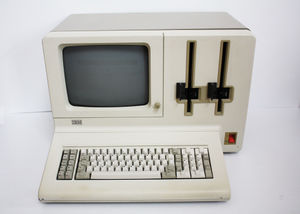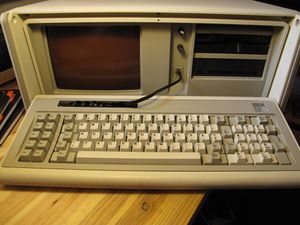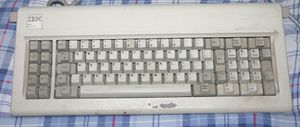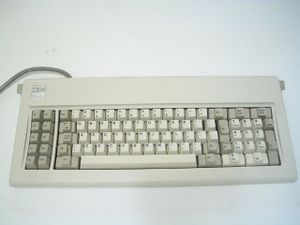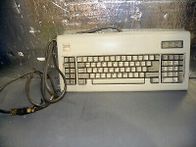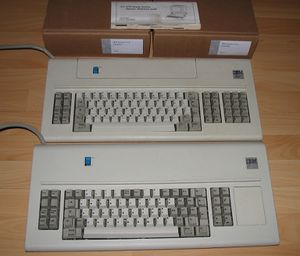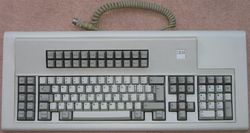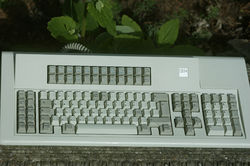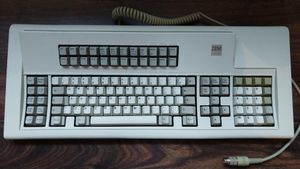IBM Model F
| Part number | Various (see below) |
|---|---|
| Branding | IBM |
| Manufacturer | IBM |
| Layouts | Various |
| Keyswitches | IBM capacitive buckling spring |
| Interface | XT, AT, others |
| Years of production | 1981—1994 |
Model F was the designation given by IBM to their buckling spring over capacitive keyboards, manufactured by IBM and Lexmark starting in 1981 and continuing through the mid-1990s. The best known Model Fs are the IBM Personal Computer keyboard and the IBM Personal Computer AT keyboard. They were also made for a wide variety of other IBM computers and terminals, and for some of the IBM Electronic Typewriter family.
First appearing in the System/23 Datamaster of 1981, the Model F design was used in most IBM keyboards of the early to mid-1980s. By 1983, however, IBM had designed the much cheaper and simpler Model M. After the Model F AT that initially came with the IBM PC AT, IBM shifted mostly to the Model M, although certain terminal Model F variants continued to be produced. Some Model Fs have been observed with production dates as late as 1994. It is unclear when production of new Model F parts ended, because later Model Fs may have been assembled out of spare parts. Unlike the Model M, the Model F designation is not always shown on the back of the keyboard. It can sometimes be found on the label on the backplate of the keyboard assembly, or it may be completely absent.
With the exception of the IBM PC AT, most Model F keyboards require an active hardware adapter to be reliably used with PS/2 or USB on a modern PC.
Contents
- 1 Common design features
- 2 Keyboards
- 2.1 IBM System/23 Datamaster keyboard
- 2.2 IBM Personal Computer keyboard
- 2.3 IBM CS/9000 keyboard
- 2.4 IBM Portable Computer keyboard
- 2.5 IBM EMR keyboard
- 2.6 IBM TPC keyboard
- 2.7 IBM 5291 keyboard
- 2.8 IBM 3178 keyboards
- 2.9 IBM Personal Computer AT keyboard
- 2.10 IBM Displaywriter Model F keyboard
- 2.11 IBM 104-key Model F keyboards
- 2.12 IBM 122-key Model F keyboards
- 2.13 IBM 4980 keyboard
- 3 Clones
- 4 See also
- 5 References
- 6 External links
Common design features
Model F keyboards were the first to use IBM's buckling spring key mechanism, designed to replace IBM's costlier and more complex beam spring keyboards. They were lighter and more compact, to the extent that IBM's sales literature described them as "low profile" and "ergonomic". The Model F utilized the same capacitive sensing technology as the beam spring keyboards with very similar electronics and PCBs.[1]
The Model F's internal assembly consists of a curved steel back plate and a curved steel top plate with the switches and PCB sandwiched in between. The flexible PCB has slots in it that slide onto pegs on the back plate, and it conforms to the curve of the bottom plate when attached. There may be a thin plastic sheet between the PCB and the back plate, presumably to help electrically insulate them from each other. The springs with their attached hammers (the 'Pivot Plate Assemblies' in IBM terminology) are housed in removable barrel modules that slide into holes on the upper plate, with an additional notch or peg to maintain the alignment. The barrels with pegs are commonly referred to as "XT" barrels, and are found on XT-layout Model Fs, and the 3178 Model F and its relatives. The barrels with notches are commonly referred to as "AT" barrels, and are found on the Model F AT and nearly every other type of Model F. The pegs on "XT" barrels would interfere with the stabilizer wires found on AT, 4704, and 122-key Model Fs, which may have been the reason IBM changed the design. All model F keys that are unstepped and wide enough to require stabilization use wire stabilizers. The Model F AT's enter key uses a combination of a horizontal wire stabilizer and a rectangular stabilizer insert in the barrel that the \| key normally occupies. The "rod" stabilizers found in most Model Ms beginning in 1985 do not appear in Model Fs.

There is a sheet of foam with holes in it that goes in between the switches and the top plate which maintains constant pressure between the top and back plates. This foam is prone to degradation. The top and back plates are held together with a series of interlocking tabs, with one longer tab from the top plate folded over the bottom plate to keep them from moving relative to each other.
Model F keycaps are the same dye-sublimated PBT as those used in the later Model M, although over time there were changes to the dyesub characteristics and slight changes in the design of the slider. The first Model Fs launched with one-piece keycaps, but the later 122-key PC 3270 and 3179 terminal keyboards started using two-piece keycaps. IBM sold some sets of the top part of the two-piece keycaps for users to change the layout of their keyboard themselves.
All the keycaps on the Model F are the same profile and can be used on any row. The curve of the assembly simulates a curved keycap profile, in contrast to IBM's beam spring keyboards and Cherry's G80 keyboards which have a unique keycap profile for each row to achieve a curve relative to the flat switch plate.
Keyboards
IBM System/23 Datamaster keyboard
The first Model F keyboard appeared on the IBM System/23 Datamaster, released one month before the IBM PC. It was an 83-key keyboard mounted internally in the Datamaster unit. Its physical and functional layout was similar to that of the IBM 5251 terminal. When the Datamaster's engineers subsequently designed the PC, they convinced their superiors to use the same keyboard, thus spawning Model F variants for a number of other IBM computers.
The original Datamaster system was known as the 5322. In 1982, IBM launched the 5324 system.[2] Amongst other differences, the newer model was not an all-in-one system, and instead had separate display, keyboard and processor units. The 5324 keyboard looks similar to the later 5291 terminal keyboard, except the legends on the keycaps are the same as that of the integrated keyboard on the original 5322 Datamaster system.
IBM Personal Computer keyboard
This is the standard keyboard bundled with the iconic IBM PC computer launched in 1981, also known as IBM 5150, and thus became the most iconic IBM Model F keyboard despite being based on the previous Datamaster design.
IBM CS/9000 keyboard
The CS/9000 of 1982 —also known as the System 9000— was a laboratory computer based on a Motorola 68000 CPU. Its keyboard was electronically interchangeable with that of the PC and PC/XT, and had a layout similar to the 5150.
IBM Portable Computer keyboard
The 5155 Portable PC was a briefcase-style portable computer released in 1984. It used the standard PC/XT keyboard with some modifications: the keyboard attached over the front of the case when not in use. It used a 6P6C RJ-25 connector with a thinner cable, and included an adapter to DIN-5 so it could be used with a standard PC.
IBM EMR keyboard
The EMR keyboard appears to have been used in specialized TEMPEST-hardened versions of IBM PCs designed to block electromagnetic signals that could be illicitly monitored. It appears to be a standard PC/XT Model F with a different cable and connector, and with shielding around the controller card inside the keyboard.
Examples have been seen with Caps Lock located to the left of A, Ctrl located to the left of the spacebar, and Alt to the right of the spacebar. Known examples were for PC/XT-style systems, but there may have been some variants of the 122-key terminal, AT, and Model M Enhanced Keyboards with similar cable/connector modifications. The EMR keyboard used a DIN connector with a shielded cable, and the EMR II keyboard used a 4-pin D-SUB connector.
IBM TPC keyboard
The TPC keyboards are very similar to the EMR keyboards mentioned above. Both PC/XT and PC/AT compatible variants have been found, with the PC/AT variant being built around the F/AT keyboard. Major differences include a shielded, uncoiled cable with a serial connector at the end, as well as copper shielding around the controller and rubber-insulated components. Despite the difference in cable and plug, the keyboard utilizes the AT protocol.
- IBM TPC keyboard IV
IBM 5291 keyboard
IBM's 5291 terminals also did not use the same keyboard as the Datamaster, mounted in a larger case than the PC/XT keyboard. (For this reason, aficionados often refer to the 5291 as "Bigfoot".) It had the same functional layout as the 5251 terminal keyboard, and attached to the terminal with a 15-pin connector. An unusual feature was the keyboard's three-stage risers. US-layout variants had the part numbers 4176191[3] and 1397950.
IBM 3178 keyboards
The IBM 3178 was a low-cost 3270 terminal based on the 3101 launched in 1983. Much like the 3278, it had an array of 75- and 87-key options, and used the same physical and functional layouts as its beam spring predecessors. It had no risers, and the 75-key variants used the same enclosure as the 87-key ones, with the number-pad area covered. The keyboards' back labels show the model of the terminal they are intended for—C1 through C4.
IBM 3101 Model F keyboard
In 1983, IBM replaced the beam spring 3101 keyboard with a Model F 3178 keyboard bearing the 3101's functional layout. The two keyboards were electronically interchangeable.
IBM 3104 keyboard
The 3104 was a low-cost mainframe terminal. It had a limited subset of the 3178's keyboard options and its own part numbers. It is unclear if they were compatible with the keyboards used on the 3178.
IBM Personal Computer AT keyboard
The Personal Computer Advanced Technology (PC AT), released in 1984, was the successor to the IBM PC and XT. Its revamped design was probably the final Model F keyboard design before the first Model M's appeared later that year. The layout was modified to address criticisms of the earlier PC keyboard, and somewhat resembled the layout of the IBM Displaywriter. The communications protocol between keyboard and computer was also redesigned, with bidirectional signals supporting lock lights. Despite its incompatibility with the older PC keyboard, the PC AT used the same DIN-5 connector. The AT keyboard protocol became standard, and is compatible with that of PS/2 keyboards, enabling it to be used with PS/2 connections via a simple DIN-to-PS/2 adapter. The US layout variant has the part number 6450200.
IBM Displaywriter Model F keyboard
The IBM Displaywriter launched with a beam spring keyboard, but in 1982, IBM began offering a Model F keyboard for it. They were marketed as "low profile, ergonomic" alternatives to the enormous beam spring keyboards. It was available only in the 84-key, 96-character layout, and not the less common 82-key, 92-character layout. The Displaywriter Model F has a unique all-pearl color scheme, and so far only German language versions have been found.
IBM 104-key Model F keyboards
The 104-key Model F was the predecessor to the 122-key Model F keyboards, and is colloquially referred to as the "Unsaver". It is a common misconception that the Unsaver was introduced after the 122-key Model F keyboards, when in fact it was introduced several months ahead of the first terminal [emulator] with a 122-key Model F keyboard. The Unsaver was primarily associated with two IBM systems - the IBM 3290 Information Panel series and the IBM 5080 Graphics System. The 3290 Model 1 (3290-1) was announced in March 1983[4] (by contrast, the IBM 3270 Personal Computer that introduced the 122-key Model F was announced in October 1983).[5] The 5080 was announced in November 1983.[6] Finally, the IBM 3290 Model 2 series was announced in October 1985 with a model 220 (that included an Unsaver) and 230 (that included a 122-key Model M).[7]
There were two major design iterations, or types, of Unsaver. The first type, which was intended for 3290-1 and 5080, featured one 15-pin (DA-15) and one 25-pin (DB-25) D-subminiature connector on the back. The DB-25 connector was used to connect the keyboard to a 3290-1 or 5080's 5085 attachment processor, and the DA-15 connector was used to connect peripherals such as the 5080's Lighted Program Function Keyboard or the 3290-1's and 5080's 24/25 key keypad. On the bottom of Type I, there was an adjustable clicker and a [redundant] bank of 4 DIP switches. The second type of the Unsaver, which was introduced with 3290-220, removed Type I's clicker and changed the location and size (to 8-position) of its DIP switch bank. Type II retains the holes on the back of the case for Type I's D-subminiature connectors, but they are hidden behind a plastic cover with a notch for a fixed cable terminating in a 240° 5-pin DIN connector.
IBM later offered a visually similar 104-key keyboard for the IBM 3191 Display Station,[8] IBM 3192 Color Display Station[9] and 3270-compatible IBM InfoWindow Display Stations (ie, 3471[10] and 3472). These were referred to as "Quiet Touch" keyboards and were made by Micro Switch and used their ST Series switches. As such, these are not related to Model F keyboards on a technical level - they were constructed differently to the 104-key Model F keyboards and the assemblies cannot be switched between the keyboards. A Model M assembly also cannot be modified to fit in the Quiet Touch 104-key keyboard.
IBM 122-key Model F keyboards
The 122-key keyboards used originally for the PC 3270 (an XT with terminal emulation software and hardware) and later the 3179 and 3180 terminals. Part number 611034x, depending on version, layout, and whether it was for use with an emulator or actual terminal. It used a 240-degree DIN-5 connector. The layout was arguably inspired by the DEC LK201, and seems to have been the basis for the layout of the later Model M Enhanced Keyboard. They can be distinguished from the Model M 122-key keyboards by their black metal underside (as opposed to plastic on the Model M equivalents). Unlike other dedicated terminal keyboards, which have a number of blank keys that do nothing, the PC terminal emulator keyboards actually make use of all 122 keys.
IBM PC 3270/3179/3180
P/N 6110346
This is a 3179 Data Entry keyboard.
IBM 4980 keyboard
The 4980 was a terminal for the IBM Series/1 minicomputer, which used a 127-key Model F keyboard. Based on the regular 122-key keyboard, it had additional keys that made its layout more similar to the beam spring keyboards on older Series/1 terminals. (122-key Model F's have contacts for the extra keys of the 127-key layout.)
Clones
The design and layout of IBM Model F—in particular the AT version— was widely copied by other keyboard manufacturers in both the US and the Far East.
See also
References
- ↑ Tom Wong-Cornall — IBM Capsense USB keyboard controllers Dated 2014-05-20. Retrieved 2024-05-07.
- ↑ IBM — IBM 5324 Product Announced (Wayback Machine) Last revised 1982-02-22. Archived 2019-04-14.
- ↑ Recycled Goods — IBM 4176191 74 Key Serial Keyboard Retrieved 2024-05-07.
- ↑ IBM — IBM 3290 INFORMATION PANEL (#183-033) Last revised 1983-03-08. Retrieved 2024-05-07.
- ↑ IBM — IBM 3270 PERSONAL COMPUTER (#183-129) Last revised 1983-10-18. Retrieved 2024-05-07.
- ↑ IBM — IBM 5080 GRAPHICS SYSTEM FOR HIGH PERFORMANCE CAD/CAM, DATA, AND ENGINEERING/SCIENTIFIC GRAPHICS (#183-145) Last revised 1983-11-01. Retrieved 2024-05-07.
- ↑ IBM — IBM 3290 INFORMATION PANEL MODELS 220 AND 230 REPLACE IBM 3290 MODEL 1 (#185-115) Last revised 1985-10-01. Retrieved 2024-05-07.
- ↑ IBM — IBM 3191 DISPLAY STATION MODELS A30 AND B30 (#187-025) Last revised 1987-02-17. Retrieved 2024-05-07.
- ↑ WorthPoint — Vintage IBM 104-key "Model F" Keyboard 73X3860 Type 3192-G Model 00 (archived eBay listing) Retrieved 2024-05-07.
- ↑ IBM — IBM Infowindow 3471 Display Station Last revised 1989-06-20. Retrieved 2024-05-07.
External links
- Admiral Shark's Keyboards — IBM Model F keyboards

